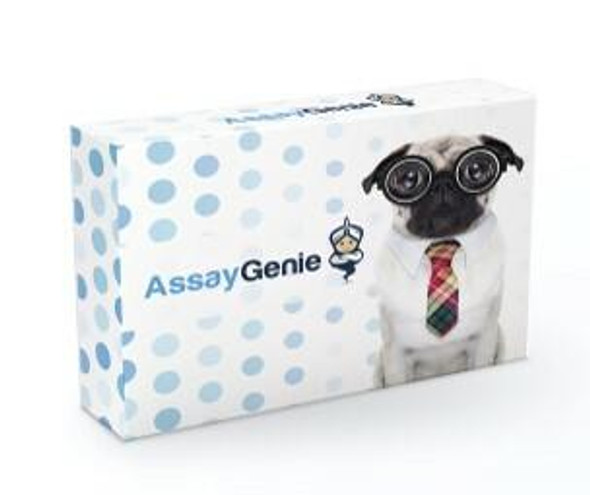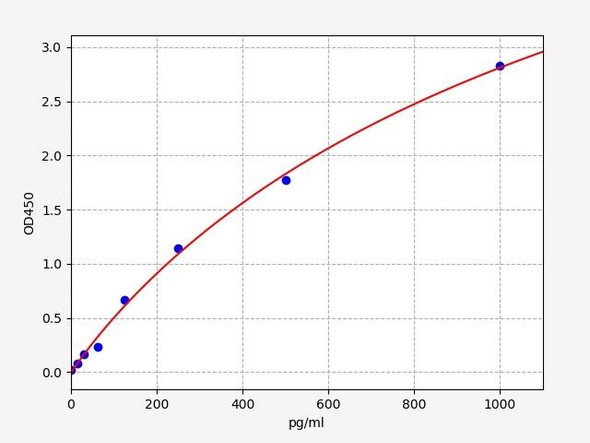Human Galectin-1 ELISA Kit (HUFI00452)
- SKU:
- HUFI00452
- Product Type:
- ELISA Kit
- Size:
- 96 Assays
- Uniprot:
- P09382
- Sensitivity:
- 0.469ng/ml
- Range:
- 0.781-50ng/ml
- ELISA Type:
- Sandwich
- Synonyms:
- GAL1, Galectin 1, LGALS1, BHL, Galaptin, GBP, L-14, 14 kDa laminin-binding protein, Gal-1, galectin 1, galectin-1, GBP, HBL, HLBP14, HPL, Lactose-binding lectin 1
- Reactivity:
- Human
Description
Human Galectin-1 ELISA Kit
The Human Galectin-1 ELISA Kit is specially designed for the precise quantification of galectin-1 levels in human biological samples such as serum, plasma, and cell culture supernatants. With a high level of sensitivity and specificity, this kit ensures accurate and reliable results, making it an indispensable tool for various research applications.Galectin-1 is a multifunctional protein that plays a crucial role in modulating immune response, inflammation, cell proliferation, and cell adhesion. Its dysregulation has been implicated in various diseases such as cancer, inflammatory disorders, and autoimmune diseases.
As a key biomarker for these conditions, galectin-1 holds great promise for advancing our understanding of disease mechanisms and potentially developing targeted therapeutic interventions.Overall, the Human Galectin-1 ELISA Kit offers researchers a valuable tool for studying the role of galectin-1 in health and disease, providing valuable insights into potential diagnostic and treatment strategies.
| Product Name: | Human Galectin-1 ELISA Kit |
| Product Code: | HUFI00452 |
| Size: | 96 Assays |
| Alias: | GAL1, Galectin 1, LGALS1, BHL, Galaptin, GBP, L-14, 14 kDa laminin-binding protein, Gal-1, galectin 1, galectin-1, GBP, HBL, HLBP14, HPL, Lactose-binding lectin 1 |
| Detection method: | Sandwich ELISA, Double Antibody |
| Application: | This immunoassay kit allows for the in vitro quantitative determination of Human LGALS1 concentrations in serum plasma and other biological fluids. |
| Sensitivity: | 0.469ng/ml |
| Range: | 0.781-50ng/ml |
| Storage: | 4°C for 6 months |
| Note: | For Research Use Only |
| Recovery: | Matrices listed below were spiked with certain level of Human LGALS1 and the recovery rates were calculated by comparing the measured value to the expected amount of Human LGALS1 in samples. | ||||||||||||||||
| |||||||||||||||||
| Linearity: | The linearity of the kit was assayed by testing samples spiked with appropriate concentration of Human LGALS1 and their serial dilutions. The results were demonstrated by the percentage of calculated concentration to the expected. | ||||||||||||||||
| |||||||||||||||||
| CV(%): | Intra-Assay: CV<8% Inter-Assay: CV<10% |
| Component | Quantity | Storage |
| ELISA Microplate (Dismountable) | 8×12 strips | 4°C for 6 months |
| Lyophilized Standard | 2 | 4°C/-20°C |
| Sample/Standard Dilution Buffer | 20ml | 4°C |
| Biotin-labeled Antibody(Concentrated) | 120ul | 4°C (Protect from light) |
| Antibody Dilution Buffer | 10ml | 4°C |
| HRP-Streptavidin Conjugate(SABC) | 120ul | 4°C (Protect from light) |
| SABC Dilution Buffer | 10ml | 4°C |
| TMB Substrate | 10ml | 4°C (Protect from light) |
| Stop Solution | 10ml | 4°C |
| Wash Buffer(25X) | 30ml | 4°C |
| Plate Sealer | 5 | - |
Other materials and equipment required:
- Microplate reader with 450 nm wavelength filter
- Multichannel Pipette, Pipette, microcentrifuge tubes and disposable pipette tips
- Incubator
- Deionized or distilled water
- Absorbent paper
- Buffer resevoir
| Uniprot | P09382 |
| UniProt Protein Function: | Galectin-1: May regulate apoptosis, cell proliferation and cell differentiation. Binds beta-galactoside and a wide array of complex carbohydrates. Inhibits CD45 protein phosphatase activity and therefore the dephosphorylation of Lyn kinase. Homodimer. Binds LGALS3BP. Interacts with CD2, CD3, CD4, CD7, CD43 and CD45. Interacts with laminin (via poly-N- acetyllactosamine). Expressed in placenta, maternal decidua and fetal membranes. Within placenta, expressed in trophoblasts, stromal cells, villous endothelium, syncytiotrophoblast apical membrane and villous stroma. Within fetal membranes, expressed in amnion, chorioamniotic mesenchyma and chorion. Expressed in cardiac, smooth, and skeletal muscle, neurons, thymus, kidney and hematopoietic cells. |
| UniProt Protein Details: | Protein type:Cell adhesion Chromosomal Location of Human Ortholog: 22q13.1 Cellular Component: extracellular matrix; extracellular space; proteinaceous extracellular matrix; cell surface; cytoplasm; intracellular; nucleus Molecular Function:signal transducer activity; protein binding; protein homodimerization activity; lactose binding; galactoside binding; laminin binding; glycoprotein binding Biological Process: regulation of apoptosis; response to drug; myoblast differentiation; positive regulation of I-kappaB kinase/NF-kappaB cascade; plasma cell differentiation; apoptosis; T cell costimulation; positive regulation of erythrocyte aggregation; response to axon injury; signal transduction; multicellular organismal response to stress |
| NCBI Summary: | The galectins are a family of beta-galactoside-binding proteins implicated in modulating cell-cell and cell-matrix interactions. This gene product may act as an autocrine negative growth factor that regulates cell proliferation. [provided by RefSeq, Jul 2008] |
| UniProt Code: | P09382 |
| NCBI GenInfo Identifier: | 126155 |
| NCBI Gene ID: | 3956 |
| NCBI Accession: | P09382.2 |
| UniProt Secondary Accession: | P09382,Q9UDK5, B2R5E8, |
| UniProt Related Accession: | P09382 |
| Molecular Weight: | 14,716 Da |
| NCBI Full Name: | Galectin-1 |
| NCBI Synonym Full Names: | lectin, galactoside-binding, soluble, 1 |
| NCBI Official Symbol: | LGALS1 |
| NCBI Official Synonym Symbols: | GBP; GAL1 |
| NCBI Protein Information: | galectin-1; HBL; HPL; gal-1; HLBP14; galaptin; galectin 1; 14 kDa lectin; S-Lac lectin 1; lactose-binding lectin 1; 14 kDa laminin-binding protein; putative MAPK-activating protein PM12; beta-galactoside-binding lectin L-14-I; beta-galactoside-binding protein 14kDa |
| UniProt Protein Name: | Galectin-1 |
| UniProt Synonym Protein Names: | 14 kDa laminin-binding protein; HLBP14; 14 kDa lectin; Beta-galactoside-binding lectin L-14-I; Galaptin; HBL; HPL; Lactose-binding lectin 1; Lectin galactoside-binding soluble 1; Putative MAPK-activating protein PM12; S-Lac lectin 1 |
| Protein Family: | Galectin |
| UniProt Gene Name: | LGALS1 |
| UniProt Entry Name: | LEG1_HUMAN |
*Note: Protocols are specific to each batch/lot. For the correct instructions please follow the protocol included in your kit.
Before adding to wells, equilibrate the SABC working solution and TMB substrate for at least 30 min at 37°C. When diluting samples and reagents, they must be mixed completely and evenly. It is recommended to plot a standard curve for each test.
| Step | Protocol |
| 1. | Set standard, test sample and control (zero) wells on the pre-coated plate respectively, and then, record their positions. It is recommended to measure each standard and sample in duplicate. Wash plate 2 times before adding standard, sample and control (zero) wells! |
| 2. | Aliquot 0.1ml standard solutions into the standard wells. |
| 3. | Add 0.1 ml of Sample / Standard dilution buffer into the control (zero) well. |
| 4. | Add 0.1 ml of properly diluted sample ( Human serum, plasma, tissue homogenates and other biological fluids.) into test sample wells. |
| 5. | Seal the plate with a cover and incubate at 37 °C for 90 min. |
| 6. | Remove the cover and discard the plate content, clap the plate on the absorbent filter papers or other absorbent material. Do NOT let the wells completely dry at any time. Wash plate X2. |
| 7. | Add 0.1 ml of Biotin- detection antibody working solution into the above wells (standard, test sample & zero wells). Add the solution at the bottom of each well without touching the side wall. |
| 8. | Seal the plate with a cover and incubate at 37°C for 60 min. |
| 9. | Remove the cover, and wash plate 3 times with Wash buffer. Let wash buffer rest in wells for 1 min between each wash. |
| 10. | Add 0.1 ml of SABC working solution into each well, cover the plate and incubate at 37°C for 30 min. |
| 11. | Remove the cover and wash plate 5 times with Wash buffer, and each time let the wash buffer stay in the wells for 1-2 min. |
| 12. | Add 90 µl of TMB substrate into each well, cover the plate and incubate at 37°C in dark within 10-20 min. (Note: This incubation time is for reference use only, the optimal time should be determined by end user.) And the shades of blue can be seen in the first 3-4 wells (with most concentrated standard solutions), the other wells show no obvious color. |
| 13. | Add 50 µl of Stop solution into each well and mix thoroughly. The color changes into yellow immediately. |
| 14. | Read the O.D. absorbance at 450 nm in a microplate reader immediately after adding the stop solution. |
When carrying out an ELISA assay it is important to prepare your samples in order to achieve the best possible results. Below we have a list of procedures for the preparation of samples for different sample types.
| Sample Type | Protocol |
| Serum | If using serum separator tubes, allow samples to clot for 30 minutes at room temperature. Centrifuge for 10 minutes at 1,000x g. Collect the serum fraction and assay promptly or aliquot and store the samples at -80°C. Avoid multiple freeze-thaw cycles. If serum separator tubes are not being used, allow samples to clot overnight at 2-8°C. Centrifuge for 10 minutes at 1,000x g. Remove serum and assay promptly or aliquot and store the samples at -80°C. Avoid multiple freeze-thaw cycles. |
| Plasma | Collect plasma using EDTA or heparin as an anticoagulant. Centrifuge samples at 4°C for 15 mins at 1000 × g within 30 mins of collection. Collect the plasma fraction and assay promptly or aliquot and store the samples at -80°C. Avoid multiple freeze-thaw cycles. Note: Over haemolysed samples are not suitable for use with this kit. |
| Urine & Cerebrospinal Fluid | Collect the urine (mid-stream) in a sterile container, centrifuge for 20 mins at 2000-3000 rpm. Remove supernatant and assay immediately. If any precipitation is detected, repeat the centrifugation step. A similar protocol can be used for cerebrospinal fluid. |
| Cell culture supernatant | Collect the cell culture media by pipette, followed by centrifugation at 4°C for 20 mins at 1500 rpm. Collect the clear supernatant and assay immediately. |
| Cell lysates | Solubilize cells in lysis buffer and allow to sit on ice for 30 minutes. Centrifuge tubes at 14,000 x g for 5 minutes to remove insoluble material. Aliquot the supernatant into a new tube and discard the remaining whole cell extract. Quantify total protein concentration using a total protein assay. Assay immediately or aliquot and store at ≤ -20 °C. |
| Tissue homogenates | The preparation of tissue homogenates will vary depending upon tissue type. Rinse tissue with 1X PBS to remove excess blood & homogenize in 20ml of 1X PBS (including protease inhibitors) and store overnight at ≤ -20°C. Two freeze-thaw cycles are required to break the cell membranes. To further disrupt the cell membranes you can sonicate the samples. Centrifuge homogenates for 5 mins at 5000xg. Remove the supernatant and assay immediately or aliquot and store at -20°C or -80°C. |
| Tissue lysates | Rinse tissue with PBS, cut into 1-2 mm pieces, and homogenize with a tissue homogenizer in PBS. Add an equal volume of RIPA buffer containing protease inhibitors and lyse tissues at room temperature for 30 minutes with gentle agitation. Centrifuge to remove debris. Quantify total protein concentration using a total protein assay. Assay immediately or aliquot and store at ≤ -20 °C. |
| Breast Milk | Collect milk samples and centrifuge at 10,000 x g for 60 min at 4°C. Aliquot the supernatant and assay. For long term use, store samples at -80°C. Minimize freeze/thaw cycles. |






